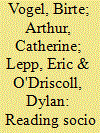|
|
|
Sort Order |
|
|
|
Items / Page
|
|
|
|
|
|
|
| Srl | Item |
| 1 |
ID:
160259


|
|
|
|
|
| Summary/Abstract |
Since regaining its independence in 2002, nation-building has been the focus of much scholarly research on Timor-Leste. National identity construction is a crucial aspect of this process, yet the ways in which this identity is officially represented has been largely overlooked. This article takes the national flag of Timor-Leste as a case study to explore the ways in which a historic East Timorese national identity has been symbolically constructed and visually embodied. By considering the potency of flags in an East Timorese cultural context, and by analysing the origins of Timor-Leste's flag alongside that of the political party Fretilin (Frente Revolucionária do Timor-Leste Independente), it becomes clear that post-independence re-imaginings of its symbolism have rendered it a powerful national symbol in the contemporary nation-state.
|
|
|
|
|
|
|
|
|
|
|
|
|
|
|
|
| 2 |
ID:
175531


|
|
|
|
|
| Summary/Abstract |
This paper argues that graffiti can provide a form of socio-political commentary at the local level, and is a valuable, yet often overlooked, resource for scholars and policymakers in conflict-affected societies. Graffiti, in its many forms, can provide rich insight into societies, cultures, social issues, trends, political discourse, and spatial and territorial identities and claims. Thus, this, paper suggests that graffiti is a valuable source of knowledge in societies undergoing social and political transformation, to hear the voices of those often left out from the official discourses. Despite advances in the field of arts and international relations and the focus on the local and the everyday, peace and conflict scholarship and policy still lack systematic engagement with arts-based contributions and how to read them. The paper attempts to address this gap by outlining four core dimensions to consider when attempting to interpret and decode graffiti: the spatial, temporal, political economic and representative dimensions. This can also be viewed as an inquiry into the where, when, who and what. These four elements make up an analytical guide and enable scholars to better understand graffiti, and its political meaning and messaging.
|
|
|
|
|
|
|
|
|
|
|
|
|
|
|
|
|
|
|
|
|